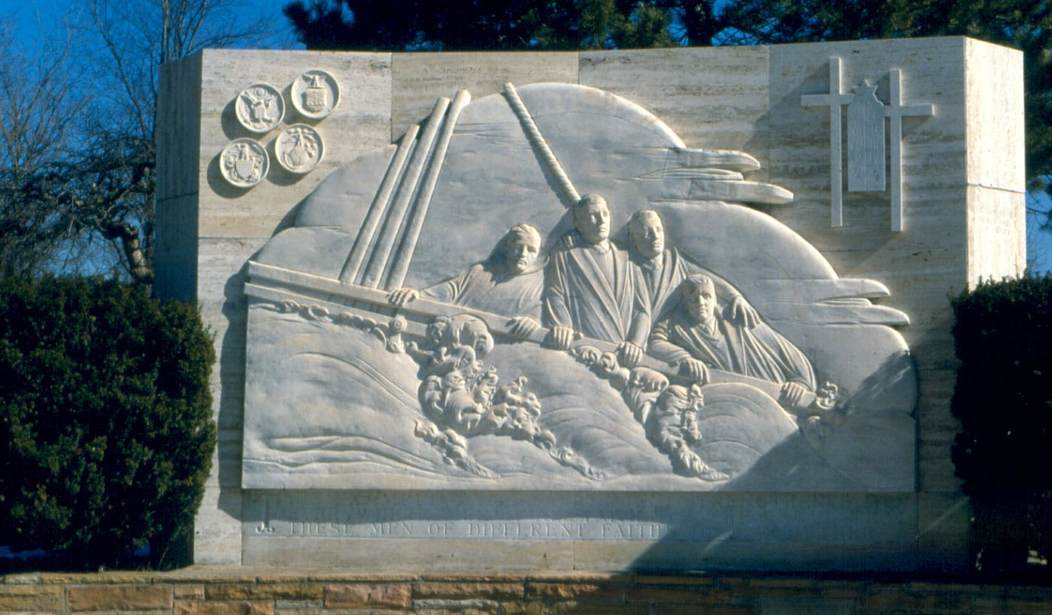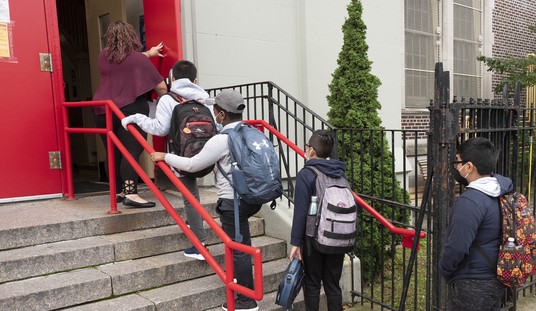When we think of military heroes, we usually think of soldiers like Audie Murphy or Marines like John Basilone and their steadfast valor while they shot at the enemy. We should honor men and women who fight like that … someone needs to fight to defend our freedom. But don’t forget the “non-combatants” like our chaplains who have gone into battle with our troops.
For this Memorial Day, remember these chaplains who selflessly sacrificed their lives:
1. Commander George Rentz, U.S. Navy.

U.S. Navy photo. From right to left are James Warner holding his son Stanley, Mrs. Warner and Chaplain George Snavely Rentz.
Commander George Snavely Rentz was a chaplain in the Navy and a veteran of both World War I and World War II. In 1942, just one year away from his retirement, he was sailing the South Pacific on the cruiser USS Houston. His ship was sailing with the Australian ship HMAS Perth to the Indian Ocean but the two were attacked by Japanese ships in the Battle of Sunda Strait. Both ships were sunk, and the crew of the Houston was ordered to abandon ship.
The 59-year-old Rentz went into the water with his fellow sailors and clung to the pontoon of a wrecked airplane. There were too many sailors and not enough pontoon for all the men to stay afloat. The chaplain said, “You men are young. I have lived the major part of my life and I am willing to go.” Each time he tried to give up his space on the float and swim away, some sailor would grab him and pull him back.
Finally, he ordered Seaman First Class Walter Beeson to take his lifejacket. He told the young man that his heart was giving out, and he couldn’t last. Beeson refused, but Rentz put it in his hands, swam away and disappeared beneath the waves. He was one of 800 men out of a crew of 1,268 who perished.
For his selfless concern for the welfare of others, the good chaplain was awarded the Navy’s second highest award, the Navy Cross. Commander Rentz is still the only chaplain to have earned the Navy Cross.
2. The four chaplains of the SS Dorchester.

The four chaplains monument in Ann Arbor, Mich. photo by Einar Einarsson Kvaran for Carlton W. Angell, Wikipedia.
Lt. George Fox was a Methodist pastor, Lt. Alexander Goode was a Jewish rabbi, Lt. John Washington was a Roman Catholic priest, and Lt. Clark Poling was a pastor in the Reformed Church. They and about 900 other U.S. Army troops were on board the SS Dorchester when, on the night of February 3, 1943, a German U-boat torpedoed them.
The chaplains calmly got the men into their lifejackets and helped with an orderly evacuation into as many lifeboats as possible. However, when it became clear that some men lost their lifejackets and there was not enough room for everyone in the lifeboats … the four chaplains gave up their lifejackets and seats in the boats.
A survivor, Grady Clark, said this: “The last thing I saw, the Four Chaplains were up there praying for the safety of the men. They had done everything they could.” The survivors saw the chaplains link arms, sing hymns together, and pray. They heard songs and prayers in English, Hebrew, and Latin…until finally the ship went under and the men were swept under the icy waves of the North Atlantic.
https://www.youtube.com/watch?v=MMwEibFO8eA
3. Captain Herman Felhoelter, U.S. Army.
Within weeks of the North Korean invasion of South Korea in 1950, the U.S. Army was in danger of being surrounded and overrun. Father Herman Felhoelter, a chaplain in the U.S. Army, was with the 19th Division in their retreat to the Pusan perimeter. However, North Korean troops had infiltrated their lines and established a roadblock, severely hindering their retreat.
About 100 American troops tried going up and over some mountains, carrying about 30 critically injured men on stretchers. Father Felhoelter and Captain Linton Buttrey (regimental medical officer) were with them. When it became clear that the troops were too weary to continue carrying the wounded men, Felhoelter and Buttrey volunteered to stay behind and take care of the wounded men so that the rest of the troops could make their retreat, and hopefully get help. Soon, the two officers were alone on the mountain top with the 30 wounded men who could not move.
North Korean troops rapidly approached, and Felhoelter told Buttrey to run for it. He knew that even though he and the doctor wore armbands and insignia on their helmets marking them as chaplains and medical personnel (unarmed noncombatants), the communists would still kill them outright. The communists fired at Buttrey, wounding him in the ankle, but he was able to get away.
U.S. troops on another mountain observed the rest of what happened. As the chaplain administered last rites and extreme unction to the wounded, the communists shot him in the head and back. Eyewitnesses say that he was leaning over a soldier and praying as he was killed. The North Korean communists then proceeded to kill all of the 30 wounded men. For his selfless act of courage, Captain Felhoelter was awarded the Distinguished Service Cross — the Army’s second highest award for bravery.
4. Major Charles Joseph Watters, U.S. Army.
Charles Watters was a Roman Catholic priest serving as a chaplain in the U.S. Army in Vietnam. He served one tour in 1966 and earned the Bronze Star for his valor in combat. When his tour was up, he volunteered to extend his tour by six months.
On November 19, 1967, Watters’ unit was attacked by a heavily armed battalion of communists. Time and time again Chaplain Watters would rush out in the thick of battle, unarmed and completely exposed to enemy fire, to pick up the wounded and personally carry them back to safety. When his troops were going to attack, he would run out ahead of them and pick up more wounded who were stuck between the two forces.
When the Americans would fall back, he would again pick up more wounded and carry them to safety. At one point, he saw a wounded paratrooper paralyzed by fear and exposed to enemy fire. Watters ran out, slung him over his shoulders, and carried him back to American lines. Back in the triage area, Father Watters was among the men assisting the doctors, praying and encouraging the troops and administering last rites.
Tragically, he and others in the triage unit were killed by “friendly fire” when a 500-pound bomb was accidentally dropped outside the field hospital. For his incredible acts of heroism above and beyond the call of duty, Chaplain Watters was awarded the Medal of Honor.
5. Lt. Vincent Capodonno, U.S. Navy.
His Marines called him “the Grunt Padre” because they all knew he was fiercely devoted to these tough infantrymen. Vincent Capodanno was a Roman Catholic priest and chaplain in the U.S. Navy, serving with the 3rd Battalion, 5th Marine Regiment in South Vietnam.
On September 4, 1967, some 2,500 North Vietnamese troops attacked the Marines. When Lt. Capodanno heard that two platoons were in danger of being overrun, he left the relative safety of the command post and rushed to be with his Marines. While under heavy fire, he tirelessly carried wounded men to safety and gave them aid. He was hit by shrapnel from mortar fire that tore holes in his legs, arms, and shredded one of his hands.
He refused medical aid, but continued gathering his Marines to safety. He spotted a critically wounded corpsman and two Marines lying on the ground. As he ran to help them, a burst of machine gun fire cut him down. For his conspicuous acts of gallantry above and beyond the call of duty, he was posthumously awarded the Medal of Honor.
Honor these men this Memorial Day, and others like them, who selflessly serve and give their lives for the cause of freedom.












Join the conversation as a VIP Member